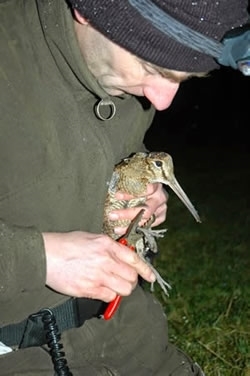 by Chris Heward, Wetlands Research Assistant
by Chris Heward, Wetlands Research Assistant
During the winter months, Andrew Hoodless and I spend a lot of our time catching and ringing woodcock, an exercise that is helping us understand the demographics of our overwintering population.
We catch woodcock at night when they leave their woodland roost site to feed on open fields. We are dependent upon very dark conditions in order to make successful catches and, as a result, we are only able to ring woodcock around the new moon.
Our first ringing sessions this season were in early October, the new moon being the 13th. We began with our usual woodcock hotspots but saw only ten birds in an area that, during the peak of the season, may hold up to fifty. It is likely that some of these birds were residents although a sighting of three woodcock feeding together is suggestive of early migrants moving as a group.
By early November this situation had changed somewhat and densities were noticeably higher. Covering the same favoured ground we saw around 30 birds on our first night. Over the following two weeks, at a range of nearby sites, we have been able to catch nearly 70 birds. Most interestingly, this has included 5 retraps; all of which were birds ringed by us in previous years that have returned to the estate.
As of last week, the brighter moonlit nights have consigned me and Andrew to our offices. This November full moon is commonly referred to as the woodcock moon since it is believed to coincide with their arrival.
It is clear, however, that many of our migrant birds here in Hampshire had already arrived prior to the full moon and numbers appeared to be increasing even during the darker new moon period. Most of the UK’s coastal bird observatories have been reporting woodcock arriving since the beginning of November.
That said, our densities are not up to their mid-winter maxima and I’m sure we will find that large numbers have arrived over the full moon. Generally we do not believe the moon has a great deal of influence over the bird’s migrations - certainly less than wind speed and direction, visibility and temperature.
Nevertheless this woodcock moon happens to coincide with falling temperatures and at times, favourable winds. Over the weekend we experienced northerly winds which are likely to assist migration, particularly for those birds arriving in the UK from Scandinavia. At the time of writing there is little wind at all.
Experience from previous years has shown us that arrival dates are variable and in most seasons the migration period is very protracted. This is to be expected given that woodcock wintering in Britain may be arriving from a range of very different destinations, each experiencing different conditions. Average densities seen whilst conducting lamp counts continue to increase even through early December in many years.
All in all it is probably too soon to say whether or not this will be a bumper winter, certainly as far as our patch of Hampshire is concerned.
Please help our UK woodcock population